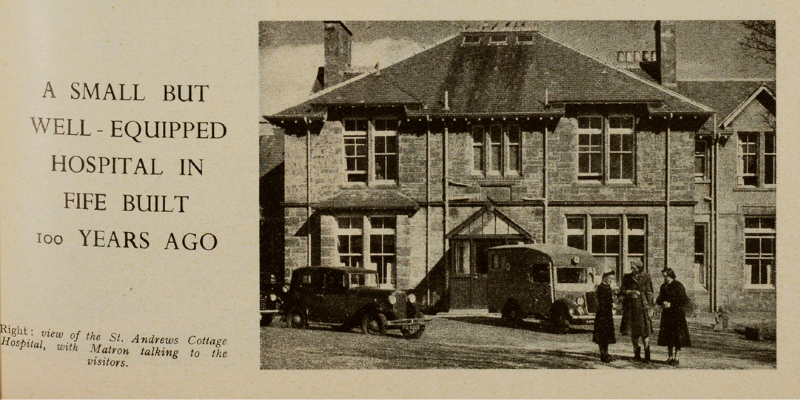
In the Library and Museum at the RCN, one of the graduate trainees is routinely tasked with curating and installing a new ‘spotlight display’ case. This is exhibited on the lower ground floor of the library and showcases some of the RCN’s unique collections which tell a story of nursing history. We are pleased to share that the new spotlight display explores the emergence of cottage hospitals in the late 19th and early 20th century, which paved the way for community nursing as we know it today.
In 1859, a rector in Cranleigh, Surrey, donated a small cottage to the local doctor. The people of the village had no heath care available to them, and so in emergencies were forced to undertake an 80-mile round trip to St Thomas’ Hospital in Southwark, London. The doctor set up ten beds in the cottage and assembled a rudimentary operating theatre – the first cottage hospital had been established. The idea was quick to take on. By 1898, 294 cottage hospitals had sprung up across the country, all relying on charitable donations to survive.
Before the cottage hospital, those who could not afford health care or travel either had to admit themselves to a workhouse when they became unwell, or simply stay at home and pray for recovery. Workhouses often had no medically trained nurses and were feared for the way they treated their inmates. Rural communities would have been familiar with these so-called ‘charitable’ institutions, many of which were later converted into hospitals. When cottage hospitals emerged, it was crucial patients did not associate them with the institutional cruelty of the workhouse and avoid seeking healthcare as a result. The wards of a cottage hospital, in contrast, were welcoming, homely, and away from the moralistic gaze of the state. Patients trusted the nurses; they were their neighbours, and likely had been serving the basic surgical and midwifery needs of their communities for generations.
Despite what some doctors in municipal city hospitals claimed, the care provided by cottage hospitals was not rudimentary or primitive. In fact, Horace Swete argues in ‘A Handy Book of Cottage Hospitals’ (1870) – one of the items in my case – that a patient has ‘a far better chance in the little hospital than in the county or city infirmary’. Another text, ‘Cottage Hospitals’ (1869) by Henry C. Burdett, also challenges the misconception cottage hospitals are unsophisticated by undertaking close statistical analysis of factors like patient mortality, infection control, and budget. For instance, Burdett directly compares the ‘Rate of Mortality [in] London Hospitals for the years 1872, 1873, and 1874’. St Thomas’ has a rate of 11.73% and Guy’s Hospital is at 10.26%, while the mortality rate of 40 local cottage hospitals cumulatively is at a low 5.4%. Put simply, the cottage patients were more likely to survive.
By the early twentieth century, cottage hospitals were firmly entrenched as pillars of the communities they served. They continued to rely on – or thrive on – donations. In the course of the research for the display, numerous journal articles were discovered celebrating the community spirit that these small hospitals engendered. It was astonishing how many village fetes, carnivals, and fundraising dinners featured in the pages of The Nursing Times which illustrated how keen local residents were to maintain the upkeep of their hospitals.
In 1948, all voluntary hospitals were transferred to the control of the newly formed NHS, and cottage hospitals were renamed ‘community hospitals’. They were better regulated, staffed, and supplied than they had been in previous years, though they no longer performed complicated surgery. Yet this did not stop local people from rallying around them, fundraising for resources like ambulances, x-ray machines, and emergency generators for the winters. ‘The Story of Much Wenlock Cottage Hospital’ (2003) – which is also featured in the display case – describes the establishment of the hospital’s ‘League of Friends’ in 1970, which was a fundraising body whose annual fete was a firm fixture ‘in the local social calendar’.
Today there are over 500 community hospitals across the UK, and community health services have up to 100 million patients per year. Though technology, medical knowledge, and infection control have improved greatly since 1859, cottage hospitals have remained a constant source of health care in rural and remote societies for 165 years.
You can view this display, entitled ‘From cottage hospitals to community nursing: a history of care in the countryside’, on the Lower Ground Floor of the RCN Library and Heritage Centre at 20 Cavendish Square. You can also keep an eye on our library social media channels, such as @rcnlibraries on Twitter/X, to be the first to hear about any more updates in our exhibition spaces.






